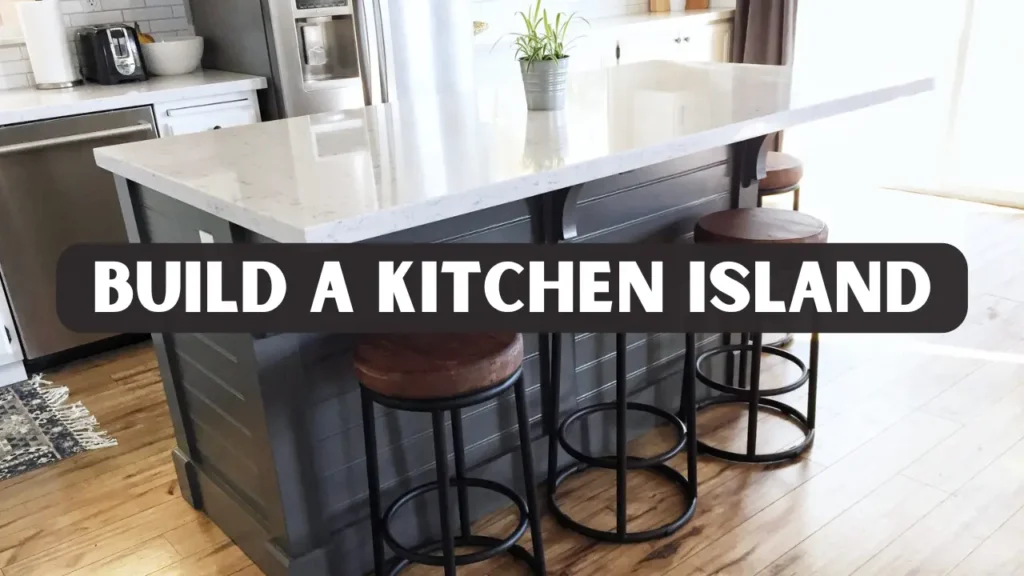A kitchen island is more than just extra surface space; it serves as a multifunctional centerpiece that enhances both style and practicality in any kitchen. Whether your kitchen is small and cozy or large and open, a well-built kitchen island provides additional storage, extra prep space, and even seating for casual meals.
For woodworking enthusiasts, building your own kitchen island is a satisfying project that combines craftsmanship, creativity, and functionality. Following a clear, step-by-step guide ensures the finished project is durable, visually appealing, and perfectly suited to your kitchen layout.
This guide will walk you through every stage of the project, from planning and material selection to assembly, finishing, expert tips, and a real-world case study. By the end, you will have the knowledge and confidence needed to build a kitchen island that elevates both the functionality and aesthetic of your kitchen.
Benefits of Building Your Own Kitchen Island
Constructing your own kitchen island offers several advantages over buying a pre-made unit. One of the main benefits is the ability to customize the island to fit your kitchen space precisely. You can adjust the dimensions, storage options, and design style to complement your kitchen seamlessly.
Another important advantage is cost. DIY construction is often more affordable than purchasing a pre-made island or hiring a professional furniture builder. By sourcing your own materials and controlling the assembly process, you can achieve a professional-quality result at a fraction of the cost.
Personalization is also a significant benefit. You can create unique details, such as lathe-turned legs, carved accents, or a custom butcher block top, giving your island character and making it a true reflection of your style. Additionally, the process of building your own kitchen island is a valuable opportunity to develop woodworking skills, including joinery, assembly, and finishing techniques.
Planning Your Kitchen Island
Careful planning is essential for a successful kitchen island project. Start by measuring your kitchen space accurately. Maintaining at least 36 inches of clearance around the island ensures that you and others can move freely while cooking or entertaining. Sketch a layout that includes appliances, seating areas, and workflow zones to ensure your island fits perfectly in the space.
Next, define the island’s purpose. If it will primarily serve as a prep station, focus on maximizing countertop space. For storage, incorporate drawers, cabinets, or open shelving to hold utensils, cookware, or pantry items. If seating is desired, add a slight overhang to accommodate stools or a breakfast bar. Some kitchens benefit from combining these functions for a versatile, multifunctional island.
Choosing a design style is another key factor. For a rustic look, use reclaimed wood, exposed joinery, and natural finishes. Modern kitchens benefit from clean lines, minimalistic designs, and painted surfaces. Transitional styles blend traditional woodworking elements with contemporary finishes, allowing your island to complement diverse kitchen aesthetics.
Finally, create a detailed materials list. Select 2×4 lumber for the frame and plywood or MDF for shelves and panels. For the countertop, choose butcher block, solid wood, or durable laminate depending on your budget and finish preferences. Include screws, brackets, drawer slides, handles, and finishing supplies such as stain, paint, or sealant. Careful selection of materials is essential when you build a kitchen island that is both functional and stylish.
Essential Tools for Building a Kitchen Island
Using the right tools ensures precision, efficiency, and safety throughout the construction process. A lathe is invaluable for crafting decorative legs and custom trim pieces, adding a professional touch to the island. Circular or miter saws allow precise cuts for the frame, shelves, and countertop components.
A drill or impact driver is essential for assembling the frame and securing hardware. Measuring tools such as a tape measure and square guarantee every cut and joint is precise, which is crucial for stability and alignment. Clamps help hold pieces in place during assembly and gluing. Sandpaper and finishing supplies are necessary to smooth surfaces and apply protective coatings, ensuring a durable, polished result. Proper use of these tools not only improves quality but also maintains builder safety.
Step by Step Guide to Build a Kitchen Island
Step 1: Construct the Base Frame
Start by assembling a rectangular frame using 2×4 lumber. Ensure the frame is level and square before attaching shelves. Reinforce the structure with wood screws and wood glue to provide stability for heavy countertops and storage areas. A well-built base frame serves as the foundation for a long-lasting kitchen island. Take your time during this step, as a precise and sturdy frame ensures that the rest of your project goes smoothly and the finished island is both safe and durable.
Step 2: Install Shelving and Storage
Cut plywood to fit inside the frame and install shelves for storage. Drawers can hold utensils, racks can accommodate baking sheets, and cubbies are ideal for small appliances. You may also incorporate a wine rack or open shelving to display decorative items. Properly secured shelves and drawers enhance both durability and usability. Additionally, carefully measuring and aligning each shelf ensures that everything fits perfectly and the island remains balanced and sturdy during everyday use.
Step 3: Create Decorative Legs and Trim
Using a lathe, craft legs that reflect your kitchen’s design style. Attach them securely to the corners of the frame. Adding trim or molding gives the island a polished, professional appearance. Decorative elements transform a functional piece into a stylish centerpiece. Take care to sand and finish the legs before installation to ensure a smooth surface and consistent color, which enhances the overall look and durability of your kitchen island.
Step 4: Attach the Countertop
Select a butcher block or solid wood countertop. Ensure a slight overhang if the island will be used for seating. Attach the countertop from underneath to maintain a seamless, clean look. A stable and properly attached countertop ensures durability and usability. Additionally, consider sealing or treating the countertop with a food-safe finish to protect it from stains, moisture, and daily wear, keeping your kitchen island looking beautiful for years.
Step 5: Sanding and Finishing
Sand all surfaces thoroughly to remove rough edges and uneven spots. Apply stain, paint, or sealant according to your desired finish, allowing sufficient drying time between coats. This step enhances both the visual appeal and longevity of the kitchen island. For best results, lightly sand between coats and apply multiple thin layers rather than a single thick coat, ensuring a smooth, professional-looking finish that will withstand daily use.
Step 6: Optional Features
Consider adding features such as heavy-duty casters to make the island mobile, hooks for utensils or towels, and under-counter or pendant lighting for better visibility. These enhancements improve functionality and make the island even more user-friendly. You can also customize storage compartments or incorporate charging stations for devices, creating a kitchen island that is not only stylish but perfectly adapted to modern living needs.
Case Study: A Real World Kitchen Island Project
To illustrate the benefits of building your own kitchen island, consider the project completed by a home chef in Chicago. This homeowner wanted a functional yet stylish island for their small kitchen. They chose to use reclaimed wood for the base and a butcher block countertop for durability and a warm aesthetic.
The homeowner incorporated drawers for utensils, open shelving for frequently used items, and lathe-turned legs to add a handcrafted touch. The total cost for the project was under $250, significantly lower than the cost of a pre-made island.
The finished island provided a comfortable prep space, additional storage, and a small seating area for casual dining. It became the centerpiece of the kitchen, combining functionality, style, and sustainability. This example demonstrates how DIY construction can achieve professional-quality results and shows exactly how to build a kitchen island that is both beautiful and practical with creativity, planning, and effort.
Tips for a Professional-Looking Kitchen Island
Precision is critical for a polished finish. Measure all components carefully and verify each measurement before cutting or assembling. Safety is essential; wearing protective glasses, gloves, and following proper tool instructions helps prevent accidents.
Adding custom details, such as carved handles, decorative inlays, or lathe-turned legs, gives your island a unique and professional appearance. Choosing durable materials, including hardwoods for the countertop and reinforced plywood for the frame, ensures your island will withstand everyday use for years.
Taking your time during assembly, sanding, and finishing is key to achieving a high-quality result. A well-built kitchen island not only serves its functional purpose but also elevates the overall style and appeal of your kitchen.
Conclusion
Building a kitchen island is a rewarding DIY project that combines creativity, skill, and practicality. With careful planning, precise execution, and attention to detail, you can build a kitchen island that enhances both the style and functionality of your kitchen. DIY construction allows for personalization, cost savings, and development of valuable woodworking skills. Whether your kitchen is modern, rustic, or transitional, a handmade island tailored to your space becomes a lasting centerpiece.
FAQs
How long does it take to build a kitchen island?
Most DIY projects take one to two weekends, depending on size, complexity, and finish details. Adding drawers, decorative legs, or seating may extend the timeline, but the results are worth the effort.
Can I build kitchen island in a small kitchen?
Yes, compact designs and rolling islands are perfect for small spaces. Maintaining at least 36 inches of clearance around the island ensures safe movement while cooking or entertaining.
What type of wood is best for a kitchen island?
Hardwoods such as maple, oak, or birch are recommended for countertops due to their durability. Pine or poplar is suitable for the frame. Using reclaimed wood adds a rustic touch while keeping costs lower.
Should I use a butcher block or laminate countertop?
Butcher block is durable, classic, and can be sanded and resealed over time. Laminate is budget-friendly, easy to clean, and resistant to stains and scratches. The choice depends on your kitchen style, intended use, and budget.
How do I make my kitchen island mobile?
Install heavy-duty caster wheels with locking mechanisms. This allows you to move the island when needed while keeping it stable during use, which is especially useful in smaller or flexible kitchen layouts.




